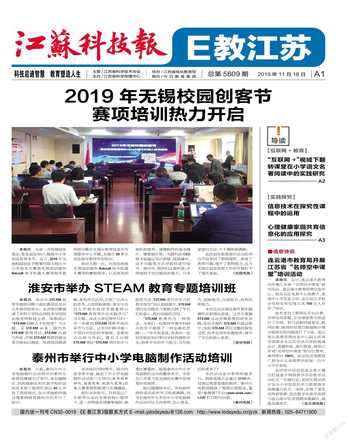Driving K-12 Innovation
【譯題】《基礎教育創新驅動力報告》——趨勢篇(二)
Poduct by CoSN (Consortium for School Networking)
美國學校網絡聯合會
SPOTLIGHTING TWO ACCELERATORS
The two accelerators featured in this report—learners as creators and personalization—present enormous opportunities to educators. Both accelerators put students at the center of learning. Both respond to megatrends in the nature of work, changing societal expectations and the pace of technology innovation. Both are among the top five accelerators that the Driving K-12 Innovation Advisory Board believes are important for school systems, schools and educators to begin addressing this year.
LEARNERS AS CREATORS (Ⅰ)
This top accelerator recognizes that creativity is a valuable, indeed essential, competency in workplaces and communities today. Merely grasping facts and concepts is not sufficient. Future-focused learning means learning by doing and making—applying knowledge and skills to solve real problems not just theoretically, but practically. Creating engages students in active and meaningful learning. Student work contributes to schools’ knowledge ecosystems as students become co-constructors of knowledge.
1.Exploring the Opportunity
Sparking students’ creativity might not seem like a radical new idea. However, traditional schooling, assessments and learning spaces don’t allow much time or space for this as a central focus of learning. But educators know that students are often naturally curious and full of ideas and questions.
Thinking of learners as creators is actually a pendulum swing. Educational titans such as Jean Piaget, Seymour Papert and Reggio Emilia regarded learning through a constructivist lens. Piaget believed educators “have to make inventors, innovators—not conformists.” He advocated fostering curiosity and providing experiential activities to help students build new knowledge from prior experiences.
Papert built on Piaget’s constructivist theories with the idea that “the ability to physically make, test, analyze, rethink, remake, and retest, as often as needed, allows for deep learning on the student’s terms.” Papert connected his ideas to new technologies that could empower students to create and collaborate. Emilia furthered constructivism through pedagogy in studio- or workshop-style spaces where artifacts become tools for reflection.
The Maker movement captures the spirit of this body of inquiry about student-focused experiences. Makerspaces are popping up all over the world, in nooks and crannies and repurposed spaces in schools, community organizations and even on wheels.
2.Imagining the Potential
The Maker movement and its relatives—fab labs, hackerspaces, STEAM labs, libraries of the future—are inspiring experimentation to reimagine the future of education, even in unlikely places:
Singapore is the perennial top-ranking nation on the Organization for Economic Cooperation and Development (OECD) Programme for International Student Assessment (PISA) and Trends in Mathematics and Science Study (TIMSS). For decades, Singapore has focused strategically on improving student achievement and has developed a reputation for“didactic teaching, rote learning and academic brilliance.”
Now, Singapore is in the midst of a “silent revolution almost entirely unnoticed in the West,” according to OECD’s Andreas Schleicher. The school system is staking its reputation on the premise that students can ace tests and be innovators and creators.
3.Driving Innovation
This accelerator is moving into education at a fast, intensive pace—and sometimes changing schooling in unplanned, surprising ways. Fortunately, an emerging body of research and thought leadership can prepare education leaders to champion learners as creators, integrate creative learning into the core instructional program and channel students’ imaginations toward productive learning activities.
The Advisory Board members offered this advice:
Take an expansive view of creativity;Integrate creative learning with the core instructional program.Develop meaningful literacies;Pay attention to rigor;Set challenging parameters to deepen learning;Broaden assessment.
聚焦兩大核心趨勢
報告指出,其中的兩個趨勢——學習者即創造者和個性化發展,為教育者帶來了巨大的發展機遇。這兩大趨勢都是以學生為中心,反映了未來工作中信息化發展的社會趨勢,改變著社會認知和技術創新的速度。這兩大趨勢在基礎教育創新驅動中名列前茅,美國教育系統、學校和教育工作者都將于今年開始對這兩大趨勢展開討論和應用。
趨勢一:學習者即創造者
這項位列第一的趨勢指出,創造力在當今工作場所和社團中是一項寶貴的甚至必不可少的能力,但僅僅掌握事實和概念是不夠的。基于未來需求的學習,是通過實踐并運用知識和技能來解決實際問題的學習,這不僅是理論上的問題,而且是實踐上的問題。為學生創建積極而有意義的學習環境,使學生成為知識的共同建構者,有助于學校知識生態系統的建立。
1.探索機遇
激發學生的創造力并不是一個激進的新想法。但是,傳統的學校教育、評估手段和學習空間并未將其作為學習的重點而提供更多的時間或空間。然而教育工作者知道,學生通常天生好奇,充滿想法和問題。
實際上,把學習者作為創造者一直處于探索之中。讓·皮亞杰(Jean Piaget)、西摩·佩珀特(Seymour Papert)和雷吉奧·埃米利亞(Reggio Emilia)等教育家都秉持學習的建構主義視角。皮亞杰認為,教育者“必須培養發明者和創新者,而不是墨守成規者”。他提倡培養學生的好奇心,提供體驗類活動,幫助學生從以往的經驗中學習新知識。
基于皮亞杰的建構主義理論,佩珀特提出新的理念:“物體的制造、測試、分析、重新思考、重新制作和重新測試的能力,有助于促進學生對術語進行深入學習。”佩珀特將他的想法與新技術聯系起來,為學生創造和協作提供了機會和條件。埃米利亞則通過工作坊或車間式的空間環境教學,進一步發展了建構主義。
創客運動抓住了“以學生體驗為中心”這一探究精神。近年來,世界各地涌現出了很多創客空間,它們在角落里、縫隙中,以及在學校、社團組織乃至車間等再利用的空間中不斷涌現。
創客空間或其他沉浸式的學習方法,例如基于項目的學習,為學生帶來了新的挑戰,學生需要在提出項目或構建解決方案之前進行廣泛的研究、信息分析和綜合,這需要具備與深度學習契合的能力。這不僅有助于學生解決問題的能力發展,也帶來了中等教育如職業和技術學院的復興。例如,學校更加注重來自真實世界的可以進行實際動手操作的任務,從而有助于學生為未來做好準備。
2.激發潛能
創客運動及其“親屬們”(工廠實驗室,黑客空間,STEAM實驗室,未來圖書館)正在努力嘗試重新構想教育的未來,即使是在不太可能的地方。
新加坡是經濟合作與發展組織(OECD,以下簡稱“經合組織”)的國際學生評估(PISA)和數學與科學研究趨勢(TIMSS)項目常年排名最高的國家。幾十年來,新加坡一直在戰略上專注于提高學生的學習成績,并在教學論、死記硬背和學術才能方面享有盛譽。
但是,據經合組織教育與技能部門主管安德烈亞斯·施萊徹(Andreas Schleicher)稱,新加坡現在正處于“西方幾乎完全沒有注意到的無聲革命”之中。學生在通過考試的前提下成為創新者和創造者,學校制度以此著稱。
3.驅動創新
這一趨勢正以一種快速、強烈的節奏進入教育領域,有時甚至以意想不到的、令人驚訝的方式改變著學校教育。幸運的是,新興的研究機構和思想領袖能夠促進教育領導者做好準備,鼓勵學習者作為創造者,將創造性學習納入教學計劃,并引導學生將想象力轉向創作性學習活動。
對此,專家咨詢委員會提供了以下建議:
創新要保持廣闊的視野;將創造性學習與核心教學計劃相結合;發展有意義的文學素養;注意保持嚴謹;設置具有挑戰性的參數以深化學習;擴大評估范圍。

